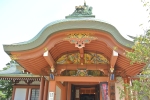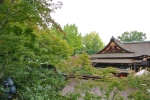
We had a day trip from Osaka to this place. Kitano Tenmangu, Kyoto, Japan. It was a beautiful place and so huge shrine.

The Kitano Tenmangu Shrine is a shrine built in the northwest section of Kyoto over 1000 years ago. The shrine was built during 947AD by the emperor of the time in honor of Sugawara no Michizane, a scholar and politician who represented the middle Heian period (794 AD – 1185 AD), as well as for the peace of the nation. Ever since, the imperial family, nobles, samurais and commoners alike all visit the shrine to worship.
The Kitano Tenmangu Shrine is the very first shrine in Japanese history where an actual person was enshrined as a deity. He is known as the “god of agriculture,” “god of honesty and sincerity,” “god of dispelling false accusations” and “god of performing arts.” However, he is best known for being the “god of academics.” Sugawara no Michizane is a historical figure who read poems at the age of five and wrote Chinese poems at the age of 11. His superior talent is what led to the dissemination of the “Tenjin faith” throughout Japan. There are as many as 12,000 shrines that are dedicated to Sugawara no Michizane in Japan, but the Kitano Tenmangu Shrine is the origin and the main shrine. To this day, many students that pray for passing scores on examinations and persons who wish for the improvement of their abilities come here to visit.

The main shrine, where the deity is enshrined, is positioned behind the worship hall, which is connected by the “Ishi-no-Ma Hall.” The main shrine, worship hall and the Ishi-no-Ma Hall have roofs above them, and by combining them all, create a large, elegant roof. This unique construction method, due to having numerous buildings, is called a “yatsumune-zukuri” (multi-building construction). The current shrine was constructed by Toyotomi Hideyori during the twelfth year of the Keicho era (1607 AD) and is designated as a national treasure.
The main shrine, Ro-mon Gate and Sanko-mon Gate were all built at the same time. They all have golden decorations, finely-detailed sculpting and vivid colors, fitting for the unique design of the Momoyama period (1573 AD – 1603 AD).

The vast shrine grounds have many more things to see. It is known as one of the nation’s best places to view ume trees. When the flowers bloom, the Bai-en (ume garden) is open to the public. The ume blossom festival on February 25 has a tea ceremony where the geiko and maiko of Kamishichiken come to serve matcha and sweets.
During the season of the red maple trees, there is the Momiji-en (autumn maple garden) where one can see 250 maple trees. Remnants of the “Odoi,” an earthen mount of fortification built by Toyotomi Hideyoshi encircling Kyoto, can be seen here as well. They are designated as national historical sites and these historic remains have fused with the natural surroundings and have become a scenic view with an atmosphere unique to Japan. Also, having its roots on the anniversary of the birth and death of Sugawara no Michizane, on the 25th of each month, there is a street market called “Tenjin-san’s Festival” that is held within the shrine grounds as well as in the outer areas. You can purchase food, sundries, used clothes and used tools at the stalls here. The market is bustling from early morning at 6 AM to 9 PM, with many visitors.
Etiquette during visit
Visiting shrines originally was done with prayer to the gods in appreciation for their daily lives and also asking to be protected in the future. Each custom that is formulated through our long history has meaning. Please enjoy your visit to the shrine while following the proper etiquette.
Before visiting, “Customs on Hand Washing”
Hand washing has its roots in the “Misogi” (purification) rituals. Sins and taints that have accumulated on the person without their knowledge were purified through dipping into the rivers or ocean. The custom gradually shifted to rinsing one’s hands and mouth. After passing through the Ro-mon Gate, you will see the Chozuya, a site for the ritual cleansing of your hands, to your right.
right.

Hold the ladle in your right hand, fill it with water, and wash your left hand with it.

Then switch the ladle to your left hand, and wash your right hand.

Hold the ladle on your right hand again, and pour some water into your left hand to rinse your mouth. At this time, do not put your lips directly onto the ladle and do not drink the water.

Wash your left hand one more time.

Hold the ladle vertically to wash the handle with the remaining water.
Basics of Visiting 1: “Ringing the Bell”

The timbre of the bell is said to dispel ominous presences and taints. It is meant as a form of purification. This does not mean that the bell should be rung loudly or for extended periods of time. Please take great care when ringing the bell.
Basics of Visiting 2: “Bow Twice, Clap Twice, Bow Once”

Bow deeply twice.

Place both hands near your heart and clap twice.

Keep your hands together on your second clap, and greet and give thanks to the Tenjin god. If there is a particular wish you have, pray for it at this point.

Bow deeply once more.
How to Hang Talismans
For those who will be hanging talismans within their residences, please place in a bright area like the living room where family members gather. Put the talismans higher than eye level. Placing them on top of cabinets or bookshelves is acceptable. Normally, talismans must be hung so that they face the south or east.
Returning Old Talismans or Charms

Nosatsu office
When receiving new talismans or charms, it is customary to return old ones to the shrine. At our shrine, there is a site to accept the old charms on the left side after going past the Ro-mon Gate. Please return the talismans and charms while expressing your gratitude to the Tenjin god.
We are early to view the Momiji-en (Autumn Maple Garden). But, anyway, we still enjoyed the vicinity of this place.
After, we walked inside the shrine for about 3 hours, we had delicious lunch a different ramen we tasted. We (Hubby and I) will definitely to go back and eat this (shiroi) White Ramen as they called.
Thank you for visiting my blog. Have a great day!
♥lovelots♥










Looks like a very good place to visit. Thanks for the sharing!
LikeLike
Yes indeed. Thanks for visiting.
LikeLiked by 1 person